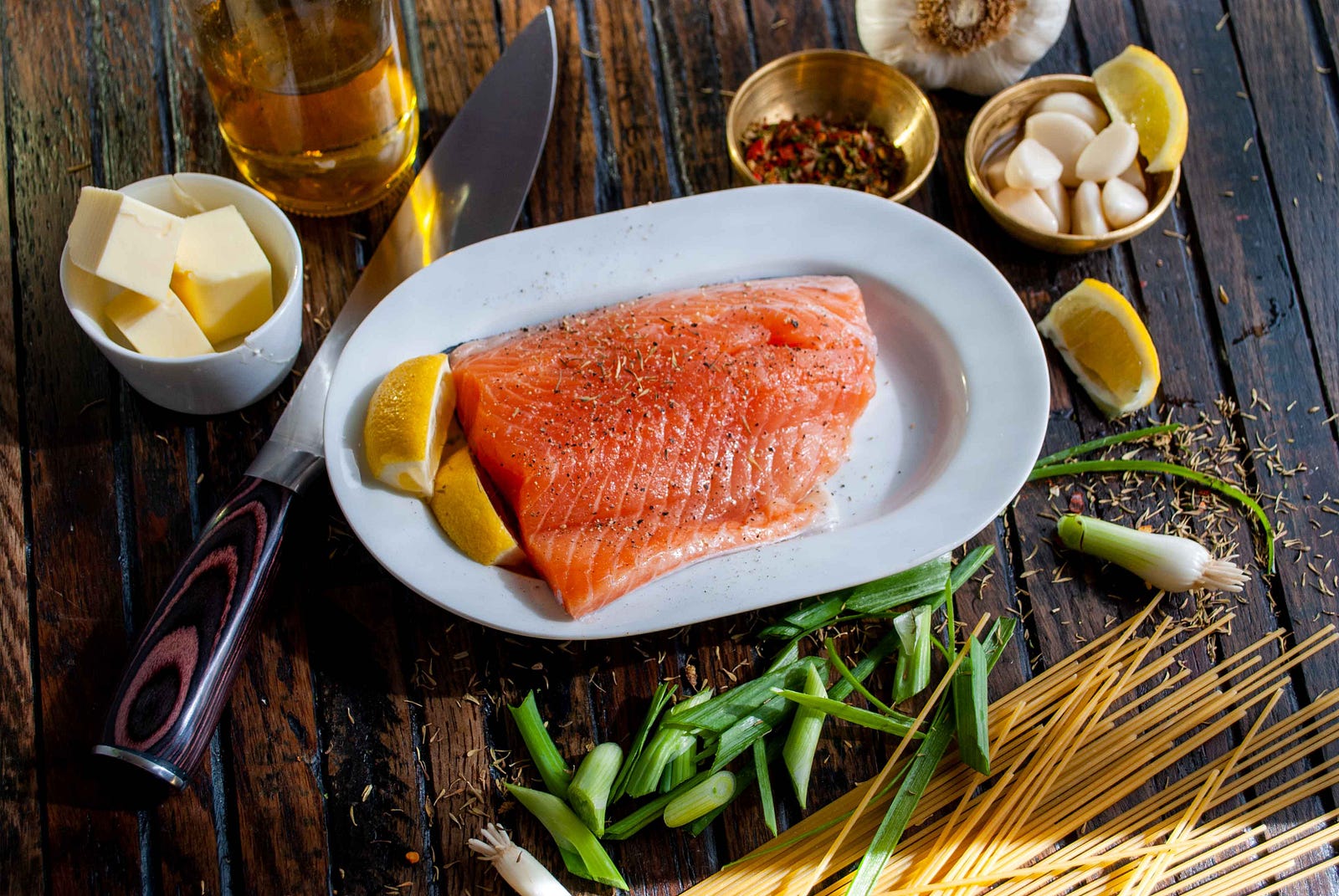If you’ve read or watched videos about keto or intermittent fasting online, you may have come across fat fasting.
Fat fasting is a type of “fast” where you eat low calories & high fat for multiple days so you can jump-start yourself into ketosis.
In this article I’ll discuss what is fat fasting & if you should do fat fasting or not to lose weight, how to fat fast, & the alternatives to fat fasting.
What is Fat Fasting?
Fat fasting is a type of “fast” where you eat a small number of calories, usually under 1k calories per day, & consume high amounts of healthy fats like oils, nuts, and avocados.
Though fat fasting isn’t technically a fast, it puts you into a really deep state of ketosis since you only eat fats & a small amount of protein.
This would lower your insulin a lot, but not as much compared to not eating at all.
But, since you’re still eating, it may be easier to do than a normal fast where you don’t eat for multiple days.
In summary, fat fasting works by putting your body into a deep state of ketosis so you can burn fat much faster.
But, there isn’t a lot of research on the benefits of fat fasting, so we aren’t 100% sure how fat fasting works & how impactful it is.

The Benefits of Fat Fasting
Fat fasting can have many benefits for weight loss and overall health.
- Weight Loss — The most popular reason for trying out fat fasting is to lose weight. As I discussed above, when you only eat a small amount of food daily that mostly comes from fat, your body goes into a deep state of ketosis. This helps you to lose weight much faster compared to just eating a normal keto diet alone.
- Improved Mental Function — Studies have shown that fasting, including fat fasting, improved their mental function and made them more creative.
- Improved Digestive Function — Fasting has been shown to improve your digestive function, including reducing symptoms of Irritable Bowel Syndrome & constipation, diarrhea, bloating, & stomach cramps.
- Increased Energy Levels — Fasting has been shown to increase your overall energy & mood. This is likely because when you use your own body fat for fuel, you always have the energy to use.
The Negatives of Fat Fasting
Of course, there are also some negatives to fat fasting.
- Hunger––A big negative about fat fasting is that you become really hungry. This is expected if you eat a really small amount of calories. But, you’d be much less hungry if you just did a normal fast. This is because, with normal fasting, your body would get so deep into ketosis that you’d stop being hungry. But, if you keep eating small amounts of food, you’d never be able to fully use your own fat for fuel.
- Fatigue––Another big negative about fat fasting is that you’d become really tired. This happens for the same reason you stay hungry during a fat fast. Its because you don’t fully use your own body fat for fuel, so you’re still slightly dependent on the food you eat for energy. But, if you just completely cut off the food, you would be much less tired since you could tap into your body fat fully.
- Less Weight Loss Compared to Normal Fasting––But, the biggest negative about fat fasting is that you lose much less weight compared to normal fasting. If you eat 2,000 calories per day, & then you eat 1,000 calories per day with fat fasting, you would only burn around 1,000 calories per day. Though that’s great for weight loss, you could lose much more weight just by doing a normal fast. With a wet fast, you would burn around 2,000 calories per day. And, with a dry fast, you would burn around a pound of fat per day.

Should You Do Fat Fasting?
If you’re looking for a way to lose weight, do normal fasting instead of fat fasting. Though fat fasting may seem easier than normal fasting, it would actually be harder. This is because when you eat food, your insulin is high, but your calories are still low, so you stop losing weight.
I recommend that, if you want to lose weight, do a normal fast instead of a fat fast.
This is because they’re both the same difficulty. If you eat a small amount of food, but still raise your insulin by eating, you would be hungry & tired.
But, with normal fasting, you eat less but still have the same amount of energy.
And since fat fasting & normal fasting are both the same difficulty, normal fasting helps you to lose more weight, just do a normal fast.
That being said, keep in mind that you shouldn’t fast if you’re at a really low body fat percentage.
How to Do Fat Fasting
- Eat Less Than 1,000 Calories––Make sure that you eat less than 1,000 calories per day. This would help you to use your own body fat for fuel & lose weight faster.
- Eat Plenty of Healthy Fats — The majority of your calories on a fat fast should come from healthy fats like oils, nuts, avocados, olive oil, butter, and nut butters. This would put you into a deep state of ketosis so you could lose weight faster.
- Stay Away From Snacks — Another important thing to remember while you’re fat fasting is to avoid snacks. Snacking would increase your insulin, which is the whole enemy of keto & fasting. So, instead of snacking, focus on eating big, but less frequent meals on your fat fast.

What Are the Side Effects of Fat Fasting?
The biggest side effects of fat fasting are that it may make you weaker, more hungry, & more tired.
If you haven’t done keto & intermittent fasting, you may get the keto flu when you start fat fasting.
When you have the keto flu, you may be:
- Fatigued
- Nauseated
- Getting Headaches
- Constipated
- Diarrheal
- More Tired During Exercise
But, as long as you add an extra 1/2 teaspoon of sea salt into your diet, you’d solve the electrolyte imbalances that caused the keto flu.
Once you do that & wait a couple of days or weeks, the keto flu would go away and you could lose weight with much more ease.
Is Fat Fasting Healthy?
Yes, fat fasting is healthy. Lowering your calories & eating keto is great for weight loss. If you have problems like insulin resistance or type 2 diabetes, fat fasting would help solve those issues.
But, don’t do a low-calorie or low-protein diet for more than a week or so.
This is because when you don’t fast, but still eat a small amount of food, your muscles would be used as energy to fill the deficit that you’re in.
That’s why the better alternative to fat fasting for both weight loss & muscle is prolonged dry fasting.

What Is Prolonged Dry Fasting?
Prolonged dry fasting is a type of fasting where you don’t eat or drink water for multiple days. Prolonged dry fasting works because your body can combine the hydrogen in your fat with the oxygen in the air to create H²O. This means that you can lose around a pound of fat per day with dry fasting.
Prolonged dry fasting, per day, is 2x more effective than wet fasting, & 4x more effective than fat fasting.
This is because with prolonged dry fasting, not only do you burn fat by not eating, but you also burn fat by using your fat for water.
Out of all the fasting types, I personally only do prolonged dry fasting because it burns the most fat whilst retaining muscle.
And since prolonged dry fasting is the same difficulty as other fasts, like fat fasting & wet fasts, I don’t see much of a benefit compared to other fasting types.
How to Do a Prolonged Dry Fast?
To do a prolonged dry fast, don’t eat or drink water for a day or two. If you’re a beginner to fasting in general, I recommend starting off with keto & intermittent fasting so you can get used to it.
But, once you’ve done keto & intermittent fasting, I recommend starting off with a two-day prolonged dry fast & working your way up from there.
This would help you to adjust to fasting so you don’t quit.
I lost most of the weight I wanted to lose with just keto & one meal a day fasting alone.
But, once I stopped losing weight, I added prolonged dry fasting on top of what I already did & I lost all the weight I wanted to.

Conclusion
Fat fasting can be beneficial for weight loss, especially when done properly. But, doing a normal fast instead of a fat fast would help you to lose more weight.
If you’ve done keto & intermittent fasting, I recommend starting off with a two-day dry fast & then working your way up from there.
If you want to learn how I lost 40 pounds with keto & one meal a day, here’s my article where I share everything I learned about keto & how you can lose weight too.
- Can You Still Lose Weight If You Aren’t in Ketosis? - February 8, 2023
- Can the Keto Diet Help With Depression? - February 8, 2023
- Why Does Processed Food Make You Fat? - January 2, 2023




